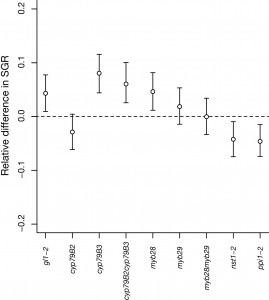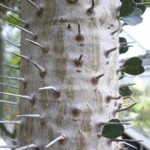Shields up!
In order to prevent depredations by the world’s herbivores, many plants choose to defend themselves. There are various ways of doing this. For example, some plants, like cacti, construct physical defences, such as spines, thorns and hairs. Some plants, however, prefer to produce toxic chemicals – if you don’t like Brussels sprouts, it’s probably because the plant would prefer not to be eaten. In order to put off potential diners, the sprout plant produces sinigrin, one of a class of compounds known as glucosinolates. These glucosinolates are produced by all members of the cabbage family – so if you don’t like sprouts, you’re probably not so keen on cabbage either.
Costs of defence?
While it seems that a cactus is prepared to defend itself to the death, other plants just don’t seem to bother. Why might this be? Well evolutionary biologists and ecologists often think in terms of trade-offs: in other words, what’s the cost of investing in something versus it’s likely pay-off? Defence is probably costly: those cactus spines are actually modified leaves, and in most plants these are the sugar factories that fuel growth. The cactus probably invests so heavily in defence because it grows in an environment where resources are scarce and every unit of growth is difficult and time-consuming to replace. In contrast, some plants grow in resource-rich environments where perhaps it’s better to lose the odd mouthful and quickly replace it, rather than invest in costly defensive compounds.
Measuring costs

Several of the defence mutants grew significantly faster than wildtype (confidence interval above the line). Interestingly, two supposedly neutral mutants (far right) seemed to have a significant growth disadvantage.
Although it seems obvious that defence should be costly, it’s actually sometimes quite hard tomeasure these costs. We tried a couple of different approaches to measuring the costs of glucosinolate production in a diminutive relative of the cabbage, the thale cress (Arabidopsis thaliana). The thale cress is in some ways a rather uninspiring plant – it’s certainly easy to overlook – however, we probably know more about its physiology and genetics than practically any other plant. First, we compared different genetic strains of the plant: we measured their growth rates and their glucosinolate content, and sure enough we found that plants producing less glucosinolate generally grew faster1. This is exactly what we expect if defensive compounds are costly to produce. Second, my PhD student, Tobias Züst, came up with a rather novel way of looking at the costs of these compounds. He used knock-out mutants, which are plants that have had the function of a specific gene disabled (or knocked out). He found that defence mutants – those that either did not produce hairs or did not produce certain glucosinolate compounds – did indeed grow faster than their wild-type relatives2.
Thus it seems that evolution constrains the possibilities: you can’t grow fast and also be heavily defended against pests; a dilemma which anyone trying to grow food will be all too aware of.
- Paul-Victor C, T Züst, M Rees, D Kliebenstein, and LA Turnbull. (2010) A new method for measuring relative growth rate can uncover the costs of defensive compounds in Arabidopsis thaliana. New Phytologist, 187, 1102-1111
- Züst T, B Joseph, KK Shimizu, DJ Kliebenstein, and LA Turnbull. (2011) Using knockout mutants to reveal the costs of defensive traits. Proc. Roy. Soc. B 278:2598-2603.

